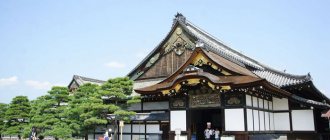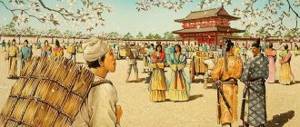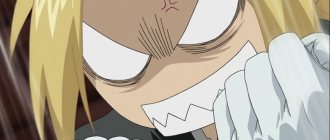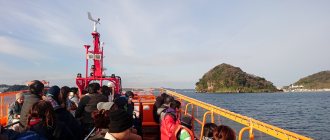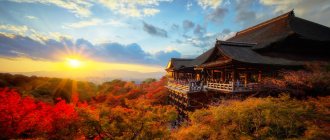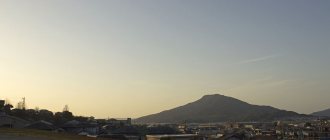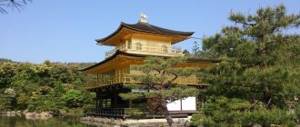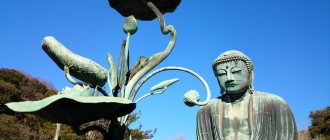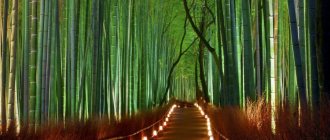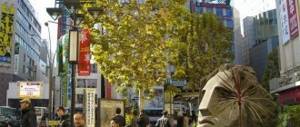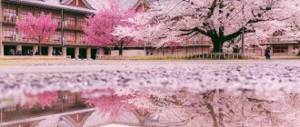Kyoto is the ancient capital of Japan. It was this city that was the residence of the Emperor for many millennia. A huge number of temples, parks and gardens are what characterizes Kyoto from a tourist point of view. To superficially explore the most popular temples, you need at least a week. But, if you only have a couple of days allotted to Kyoto, don’t despair. In my article I will write about the most visited attractions that can be visited in 1, 2 or 3 days.
Unknowingly, I allocated only two days to Kyoto in our itinerary. If you are coming to Japan for more than a week, reduce the number of days in Tokyo and increase the time to visit Kyoto. Because the most traditional, ancient sights of Japan are concentrated here.
Map of Kyoto with landmarks
The map below shows the attractions that I will write about in the article.
You can download markers for your offline navigator and a set of maps of Kyoto for printing (bonus - maps of Tokyo). To download, enter your address in the form below.
I also offer to your attention this brochure (in English), from which you can see how to get to this or that Kyoto attraction by public transport, as well as the fare. The picture is clickable.
I’ll say right away that we didn’t have time to see several main attractions, namely: the Imperial Palace and one of the symbols of Kyoto - the Golden Pavilion. I’ll tell you about them later, but for now – what you can see in Kyoto in 1 day.
Mount Arashiyama
The tradition of sakura viewing began on Mount Arashiyama. The views from this mountain are considered a national treasure. At the foot of the mountain you can see Shinto and Buddhist temples. There is a bridge across the Katsura River near the mountain, from which tourists admire the surroundings. There is a pier nearby where you can book a boat trip. At the very top there is a monkey park. Entrance to local temples will cost a tourist 400-500 yen. To get to the mountain, you need to get to the Arashiyama metro station.
What to see in Kyoto in 1 day
We arrived in Kyoto by bullet train from Tokyo (about 3 hours, free with JR Pass) around 11am. After putting our things in a traditional hotel, the Nishikiro ryokan, we went for a walk.
No. 1. Nishiki Market or Kyoto Fish Market.
You can start the day, and at the same time dine on seafood, at the Kyoto fish market. The market is a narrow street along which there are trays, tents, display cases with food (mainly fish and seafood, but there are sweets, national dishes, and sometimes something exotic (for example, sparrows!), shops, restaurants.
The place is very atmospheric and crowded. You can try fresh sushi, oysters, scallops, shrimp, and sea urchin caviar.
This set (sushi + hedgehog caviar + fresh tuna skewers) cost 1,500 yen (about 900 rubles)
No. 2. Geisha Gion Quarter
This is a traditional Japanese quarter. It began to be built up many centuries ago in order to provide housing for all the pilgrims of the Yasaka Shrine. Over time, geishas became the hallmark of the area.
Today, almost all the “geisha” you see here are dressed up tourists from Asian countries :) You can recognize them by the presence of a selfie stick :))) But this girl looked quite similar to a real geisha or geiko (google the differences on the Internet ).
Many people mistakenly consider Gion to be a red light district, but the work of geishas, as you probably know, is not related to prostitution.
No. 3. Kiyomizu Dera Temple
One of the most popular temples in Kyoto is the Kiyomizu-dera Temple or the Temple of Clear Water. In Japan, a Temple is not just one building, but a whole complex of structures. Thus, the Temple of Pure Water is famous for its wooden temple, built without a single nail. A huge wooden terrace hangs over the abyss. Unfortunately, this building is currently under reconstruction and the terrace itself is covered with scaffolding.
Also on the territory of the complex there is a three-tier pagoda, which is considered one of the tallest in Japan.
A waterfall with clear water is another object of the complex. It was he who gave the name to the Temple. The stream of the waterfall is divided into three parts and, according to legend, if you drink from these streams, you can gain health, wisdom and good luck. But don’t be greedy, you shouldn’t drink from three streams at once - the gods don’t welcome this.
Order your All Airlines card before November 30
✈️GET 4000 MILES (when spending over RUB 1000) AND EXCHANGE THEM FOR A FREE AIR TICKET✈️
Leave a request NOW and start FLYING FOR FREE>>>
The temple is located on a hill, therefore: 1. it offers panoramic views of Kyoto; 2. getting here on foot is a little difficult, because... you have to walk uphill. However, as you approach the Temple along the street, there are many shops, and if you are distracted by them, you will feel less tired. You can, of course, get there by taxi.
On the way to the temple you can get into a traffic jam. The number of geishas per square meter is off the charts :)
Also information on how to get there by public transport (info from the website, clickable)
Attraction website: https://www.kiyomizudera.or.jp/en/
No. 4. Fushimi Inari Shrine
Another temple complex is famous for the red gate called Torii. The temple is dedicated to Inari, the god of rice and patron of business. The representative of God is the fox, therefore, in the temple there are many statues and figurines of this animal.
God Inari
At the foot of the hill are the main gates - "ryomon" ("tower gate"), and the main sanctuary ("go-honden"). The torii stretch 5 km up the mountain.
Entrance to the Temple
They are bet on the money of businessmen who want to “appease” God, thereby attracting good luck to their business. The price of thorium starts at $1,600 and goes up to $12,000.
But don’t think that after paying 12,000 bucks, your thorium will be installed right away; there’s already a queue for thorium installation, because There are certain limits on how much torii can be staked per month. By the way, a story about this was shown in one of the episodes of “Heads and Tails.”
You can walk along the paths leading up as much as you like. There must be a lot of people here during the day. We arrived in the evening, the flow of tourists began to decrease, and the higher we rose, the fewer and fewer people there became.
True, in the evening all the shops and tea houses that can be found along the road were already closed.
But you can explore the sanctuaries and statues of foxes at any time of the day (and, probably, night).
Entrance to the sanctuary is free.
You can get here by metro or JR train (to the Inari station of the same name).
Attraction website: https://inari.jp/en/
Travel tips
Traveling to Kyoto is one of the safest: there are almost no thefts or attacks. The only difficulty for tourists may be the inscriptions only in Japanese. But many of the residents of Japan speak English, people here are friendly and will always help you find your way or clarify something.
Japanese style dinner consists of several small plates with various dishes
What else you need to know about Kyoto:
- Kyoto is the only place where Damascus steel is still produced. You can bring souvenirs in the form of vases, dishes, samurai swords as souvenirs;
- It is better to use ATMs in post offices: many terminals on city streets do not work with foreign cards;
- You can get around the city by city buses. There are also subway lines in Kyoto;
- You can try Japanese cuisine in cafes and restaurants on the streets of Shirakawa. Traditional Japanese dishes include hamo white fish, tofu, and the Japanese kaiseki multi-course meal. It is recommended to try the Japanese green tea matcha and the Kyoto dessert yatsuhashi.
Is it worth checking into a hotel?
If you come to Kyoto for an excursion holiday, it is worth staying here and staying in one of the hotels. In Kyoto you can find hotels in both Japanese and European styles. Attractions are not only located in the central part of the city, so it will be most convenient to stay near the city's transport hub, for example, at Kyoto Train Station.
Sights can be found in all five boroughs of the city
What to see in Kyoto in 2 days
On our second day in Kyoto, we only managed to visit 2 attractions. They will be discussed in this section.
No. 5. Arashiyama Bamboo Forest
In the Arashiyama district of Kyoto there is another attraction - the Bamboo Forest or Bamboo Grove. Many guidebooks write that this attraction is included in the list of “100 Sound Attractions of Japan”, and that the wind creates some special sounds. Perhaps if you come early in the morning, at 4 o’clock, you can hear something and feel inspired by this place. But during the day you can only hear the hum from the conversations of a huge number of tourists.
If you don't see the crowd of tourists, you can imagine the unusual sounds of the bamboo forest
Yes, they recommend arriving early, that’s what we planned, but upon entering the grove, we got lost. And while we were walking around the area, the grove was no longer crowded :)
The area is also quite pleasant to just walk around.
In the Arashiyama area Very traditional area
From Kyoto Station it takes about 25-30 minutes by JR train.
No. 6. Nara - the city of deer
Not far from Kyoto there is a small town called Nara, famous for its tame deer, which you can pet, feed, and generally sit next to (don’t get into the poop!)
The attraction is unusual, so, of course, we planned a visit to this city in advance. Getting to Nara is easy; there is a JR line train from Kyoto Station; if you have a travel pass, you can get there for free.
In the set of maps of Japan, which I wrote about above, there is also a map of Nara:
From the station to the park where there are deer, it’s about a 12-15 minute walk through the city. There are many benches and souvenir shops along the way.
Nara town
At the entrance to the park there is a Kohfukuji temple with a pagoda.
I’ll say right away that if you want to feed the deer, go deep into the park, the deer at the entrance are fed and exhausted.
By the way, there are impudent deer, such a horned one bit me on the side when I didn’t want to give him a cookie.
Impudent ass
There are a lot of temples, shrines and walking paths in the park. To be honest, I wasn’t interested in temples, so I can’t tell you. If you are interested in temples, then this information from the brochure may be useful to you (picture clickable):
At the entrance to one of the Temples of Nara The gate to one of the Temples A deer is a symbol of Nara We looked into one of the temples Traditional architecture
Reviews from tourists
If you are planning a trip to Japan not to walk around bustling metropolises, but want to admire nature and immerse yourself in the history of this country, then you definitely need to visit Kyoto! The city in which the history of Japan is concentrated. Ancient capital.
Licita
https://irecommend.ru/content/kioto-dlya-lyubitelei-istoricheskikh-mest-k-poseshcheniyu-obyazatelen-gorod-v-kotorom-sosred
Japan is an amazing country. One trip will only spark your interest and you will definitely come back here again. The culture that is surprisingly different from ours, the way of life of the Japanese, the stunning nature, history and sights, everything attracts us like a magnet. The ancient capital is Kyoto, a treasure trove for the inquisitive tourist. When you go out in the morning in search of adventure, rest assured that new discoveries and impressions are guaranteed!!!
Tatyana0506
https://tatyana0506.tourister.ru/photoalbum/37718
Everyone knows about Kyoto that there is the Guyon Quarter and geishas, the Golden and Silver Pavilions and “Japanese” gardens. In addition to the above, there are several more very beautiful temples, a Samurai Palace with creaky floors (to hear the approach of the enemy) and a quiet, cozy path of philosophers along the canal. But the Golden Pavilion at sunset is a truly unforgettable sight!
kvazar
https://venividi.ru/node/16239
In general, I have a rather twofold feeling about Kyoto: a beautiful city, beautiful parks and temples, but seeing them a second time is a little boring, although I have a great desire to visit Kyoto 3 times to see Kinkaku-ji in the snow, because even the photos on I was very impressed by the postcards.
geekkun
https://pikabu.ru/story/yaponiya_za_mesyats_chast_3_dva_dnya_v_kioto_4860651
What to see in Kyoto in 3 days or longer
In this section I will write attractions that you can still see in Kyoto, but for which we did not have enough time.
No. 7. Imperial Palace Kyoto Gosho (Kyoto Goso or Kyoto Gosho)
Imperial Palace in Kyoto, photo japanology.ru
Kyoto Gosho was founded in the 14th century and until 1868 (when the capital of Japan was moved to Tokyo) was the residence of the Emperor and his family. Taking into account the fact that the building was constantly exposed to fires, today we can see the palace built in 1855.
The Imperial Garden is surrounded by the Kyoto Gyoen National Garden. Entrance to the garden is free.
But you can only get to the Imperial Palace with a tour, which you need to sign up for in advance - at the tourist center, or online at https://sankan.kunaicho.go.jp/english/index.html
You can get there by subway, Imadegawa station
No. 8.Kinkaku-ji Golden Pavilion
The Golden Pavilion is one of the symbols of Kyoto and can often be seen on postcards and advertising brochures.
Golden Pavilion, photo https://aerobulochka.livejournal.com
This Buddhist temple, the top two floors of which are covered with real gold, is located on the shores of Lake Kyokoti and is beautifully reflected in the water surface. It was built at the end of the 14th century, and today serves as a repository for the relics of Buddha. Like most temples in Japan, Kinkaku-ji is surrounded by a garden.
The pavilion is open daily from 9am to 5pm, admission: ¥400
You can get there by metro - Kitaoji station.
Order your All Airlines card before November 30
✈️GET 4000 MILES (when spending over RUB 1000) AND EXCHANGE THEM FOR A FREE AIR TICKET✈️
Leave a request NOW and start FLYING FOR FREE>>>
No. 9. Ryoan-ji Rock Garden
Rock gardens are very popular in Japan. Their essence is that, at first glance, chaotically located stones form a certain system, based on the traditions of Zen Buddhism.
Ryoan-ji is one of the most popular. Garden 15 stones. The stones here are arranged in such a way that it is impossible to see them all at the same time. They say that only a person who has “reached enlightenment” can see all 15 stones at the same time.
To visit the garden, you need to go to the temple of the same name. Entrance to the Temple is free.
No. 10. Maruyama Park
Maruyama Park during cherry blossoms, photo kanpai-japan.com
There are a lot of parks and gardens in Kyoto, but most guidebooks recommend this one first, because... It is he who is considered the oldest in Kyoto (dating back to 1886). It is especially beautiful during hanami (cherry blossom) and momiji (red maple season)
No. 11. Nijo Castle
Nijo Castle, Kyoto, photo from the Internet
Nijo Castle is included in the UNESCO World Heritage List and is considered one of the most beautiful castles in Japan, which attracts hundreds of thousands of tourists. Construction of the castle began at the beginning of the 17th century; the castle was to become the residence of Japanese rulers.
The main objects of the castle complex are the Ninomaru Palace (Ninomaru Gōten) with 33 luxurious rooms and the Honmaru Citadel (until the 18th century there was a castle tower there).
You can get there: to the Nijojo-mae stop by buses 9, 50 and 101 from the railway station. Take the Tozai Line metro to the stop of the same name.
Ninomaru Palace is open from 9 am to 4 pm, the rest of the complex is open from 8:45 to 6 pm.
Official website: https://www2.city.kyoto.lg.jp/bunshi/nijojo/english/index.html
Admission is 600 yen, see the website for discounted ticket prices.
History and description of the city
The first mentions of the lands of Kyoto date back to the 4th century BC. e. At this time, the first temple was built in the surrounding area. The city developed rapidly, and monks and artisans began to actively populate it. In the 8th century, imperial power was under threat of a coup. The emperor was forced to move the capital, which was located in Nara, away from the influence of Buddhist monks. In the depression of Kyoto, the city of Heian was built, which meant “capital of peace and tranquility.” Kyoto arose from this city.
Until the 19th century, Kyoto retained the status of the capital and imperial residence; in the 17th–19th centuries it became the richest and most prosperous city in the country. But the fire at the Imperial Gate destroyed many buildings, of which 28 thousand were residential buildings alone. The damaged city had to be restored, and the capital was moved to modern Tokyo.
During the 1945 bombing, Kyoto was removed from the target list as a city particularly rich in historical sites.
Today, Kyoto is the capital and major city of Japan. Fishing and agriculture are developed here, and tourism is the main source of income. Kyoto is considered the most culturally valuable Japanese city. It contains 1,600 Buddhist temples, 2 Shinto temples and about 7 imperial palaces.
Table: basic information about Kyoto
| Location | Central area, Kyoto Prefecture |
| Square | 827.83 km² |
| Population | 1,472,027 people |
| Religion | Buddhism, Shintoism |
| Currency | Japanese yen |
| Timezone | UTC+9 |
| Do I need a visa | Yes |
City Tower
The highest observation deck in Kyoto is located on the city tower: at an altitude of 100 meters. The peculiarity of this metal structure is that all 800 tons of it are installed on the roof of the building. There is a hotel in the building itself and several shops. This tower has no function other than observation. Finding the tower is not difficult; it stands directly opposite the railway station building.
Fushimi Castle
Fushimi was originally built as a luxurious palace; its walls were not intended for siege. 6 years after its construction, the Toyotomi clan acquired it by force.
The interior of the castle has not survived to this day; today you can only rejoice at the restored façade of the building.
Now the palace houses a museum of the Momoyama era. Fushimi is located in the vicinity of Kyoto. You can get there by metro from the center. Travel time will be 45 minutes, the final station is called Momoyama.
Kiyomizu-dera
The history of the Buddhist temple began with one monk giving another a dry branch. The second carved the face of the deity Cannon on it, installed it on a hill and began to worship the giver of mercy. Gradually, other monks came to that place to build a full-fledged monastery there. This happened in 778, and in 1200 the abbot of the monastery healed the shogun’s wife with prayers. After this, the temple became an official sanctuary. Until the 17th century, the sanctuary was burned and looted many times, but later it was revived again and again. Before entering the temple, you need to undergo a special ritual of washing your hands in a local waterfall. It takes a long time to get to the temple: from Kiyomizu-Gojo Station you have to walk another 25 minutes. The sanctuary receives visitors every day from 6.00 to 21.00. A ticket for the tour costs 300 yen.
Manga Museum
Manga exhibitions in the city have an international status. Manga is Japanese graphic art, vaguely reminiscent of comic books. In an amazing and unique museum, it is quite possible to choose a volume of manga and go with it to the garden to watch and read while lying on the green grass. Here you can see more than 300 thousand books dedicated to this genre. On weekends, the museum building hosts master classes for aspiring artists. Buses 15, 62, and 51 go towards the museum. A two-minute walk from Manga is the Karasuma Oike stop. A visit costs 800 yen. Opening hours: from 10.00 to 17.30.
To-ji Temple
The Eastern Temple is based in the Shingon area. This defensive structure was built in 796. The temple once had two other "brothers" in Kyoto, but those other temples have not survived to this day. To-ji is included in the list of UNESCO and cultural properties of Kyoto. The shrine has the tallest wooden pagoda in Japan. The height of the tower is 55 meters. In 1603, a statue of Yakushi was installed in the Golden Hall of To-ji. On the temple grounds there is a garden with a pond where carps and turtles live. The temple is located in the south if you look for directions from Kyoto Station.
National Museum
Exhibits from the time of Japanese isolation, artwork and sculptures by famous Japanese authors are what the Kyoto National Museum presents to the public today. The first exhibitions at this site were founded in 1889. There are 12 thousand objects hidden in the museum's storage room. Only half of them make it to exhibitions. City buses 206 and 208 go to the museum complex. The doors of the establishment are open from 9.30 to 17.00. Monday is a day off. An adult ticket costs 520 yen.
